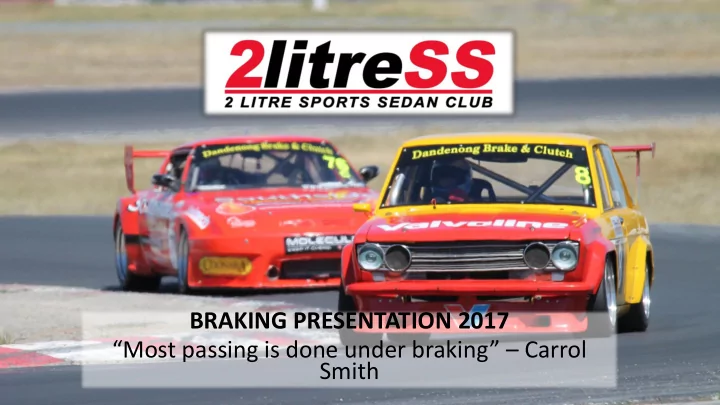

BRAKING PRESENTATION 2017 “Most passing is done under braking” – Carrol Smith
What are we trying to achieve: • Slow the vehicle at the maximum possible rate • Ensure that the driver has complete control over the vehicle • Ensure that driver effort is “reasonable” • Must have 100% reliability! • Must be “repeatable” ( ie forces don’t change much with temperature / speed) • Minimise weight • The driver must be able to “lock the wheels”, and they must also be able to modulate pedal effort as the dynamic load on the tyres changes.
Overview of the Braking System Braking force is initiated by pressing the brake pedal, this force is multiplied by the pedal ratio, and the output force from the pedal is transferred to the master cylinder(s), either directly or through a balance bar. As the master cylinder(s) piston moves, the fluid pressure rises until the force applied to the face of the piston equals the force from the balance bar assembly. The fluid pressure (line pressure) is then applied to the face of the calipers' pistons causing the calipers to squeeze the pads on the brake rotors.
In its simplest form - Braking torque 1) Master cyl Force (Fm) = Pedal force (Fp) x pedal ratio (pedal length x distance from fulcrum to master cyls) 2) Master cylinder pressure = Fm / Master cyl area (Am) This net force translates directly to pressure at caliper. 3) Force at caliper (Fc) = Fp x Piston area (Ac) 4) Braking torque = 2 x Fc x Coefficient of friction of pad/disc ( μ aka 'mu') x Radius from disc centre to centre of pad (R)
Pressure = force per unit area
Slowing the vehicle – which depends on: • Brake torque versus tyre load (weight transfer and areo loads) • Load transfer versus bias (more “G’s” = more forward load transfer) • Co-efficient of friction of tyres versus road surface (rotations slip %) • Chart on next page is a generalised “2LSS” car, 50/50 weight distribution, showing change in rear bias with increasing deceleration rate. • Ability of the driver to modulate the pedal to keep tyres just under the lock- up threshold.
Weight Transfer – changes the required braking force distribution: • This means you need to modulate the pedal with changes in velocity! Rear % required 60.0 50.0 40.0 30.0 20.0 10.0 0.0 0 0.1 0.2 0.3 0.4 0.5 0.6 0.7 0.8 0.9 1 1.1 1.2
Weight – always transfers! During any acceleration - the weight on front (W f ) and rear axle (W r ) can be calculated: W f = (c/L)*W - (h/L)*M*a W r = (b/L)*W + (h/L)*M*a, h is the height of the CG, M is the car's mass and a is the acceleration (negative in case of deceleration). • If you want to simplify this, you could assume that the static weight distribution is 50-50 over the front and rear axle. • In other words, assume b = c = L/2. In that case, W f = 0.5*W - (h/L)*M*a and W r = 0.5*W +(h/L)*M*a;
How much force is required? • Vmax • Mass • Deceleration rate • Tyres frictional characteristics • Load on said tyre (dynamic and areo) • Drag • Temp rise in components (ie pad Mu versus temp) • Stiffness of components IMHO – the driver MUST BE ABLE to generate the required line pressure with reasonable leg force, such that they are able to lock the wheels of the car, at high speeds – if not – then you do not have sufficient brake torque!!!!!!!
How to change? Its all a question of balance! We can adjust forces via: • Change in caliper’s (expensive) • Change in master cylinders (moderate) • Change in bias (bias bar versus proportioning valve) • Change in coefficient of friction
Sadly – brake pad manufactures DO NOT USE CONSISTANT METHODS in their advertised Cf “data”.
BRAKE FLUID: • Use the best quality stuff you can afford • Bleed system often • A “cheap” temperature trick is riveting thin stainless sheet to the back of pads to reduce heat transfer throu pistons and into fluid. • http://www.penrite.com.au/products.php?id_categ=9&id_products=361 • The Penrite fluid is inexpensive, and “almost” as good as the high -end brands (imho) • “SRF” – excellent, but expensive
BRAKE PADS My experience in terms of “bite”: • Carbon Lorraine (RC5/RC8)> PFC 07 & 01’s > Hawk DTC 60 / 70 > Hawk HT14 /HT10’s(v high temp) > PFC 93 / 83 > Hawk blue/black >DS11 > black flash > “green / red’s” • Have heard very positive experiences from Project Mu. • IMHO – the pad must have the Cf “linear” over the operating temp range on the track. It must also “release” with change in pressure. • This OFTEN MEANS they don’t work until up to operating temp !
TRICKS: • The Cf “linear” over the operating temp range on the track – which means you can “adjust” this with air. • Learn the difference between “boiling the fluid” / running out of temp capacity of brake pad” – solutions are different. • You DO NOT NEED to spend thousands of $ on calipers – you just need the correct total piston area. Stiffness is important. Imho – ensuring that you can get good pads to fit your particular caliper is part of the selection process! • Some race teams “throw out” pads that have been used, - it is entirely practical to “change the shape” of a pads to fit your caliper!!!!! • Very Good calculator: • http://www.locostusa.com/forums/viewtopic.php?f=5&t=4090 • By Mike Poland
Useful References: http://www.ferodoracing.com/products/car-racing/racing-brake-pads/dsuno/ http://www.wilwood.com/BrakePads/BrakePads.aspx http://hawkbrakesdirect.com/c-82-racing-brake-pads.aspx http://www.performancefriction.com/ https://www.apracing.com/ http://www.alcon.co.uk/ http://www.brembo.com/it/racing http://www.stoptech.com/technical-support/technical-white-papers/brake-fluid http://www.penrite.com.au/products.php?id_categ=9&id_products=361 http://www.fkm.utm.my/~arahim/daimlerchrysler-gritt.pdf
Recommend
More recommend